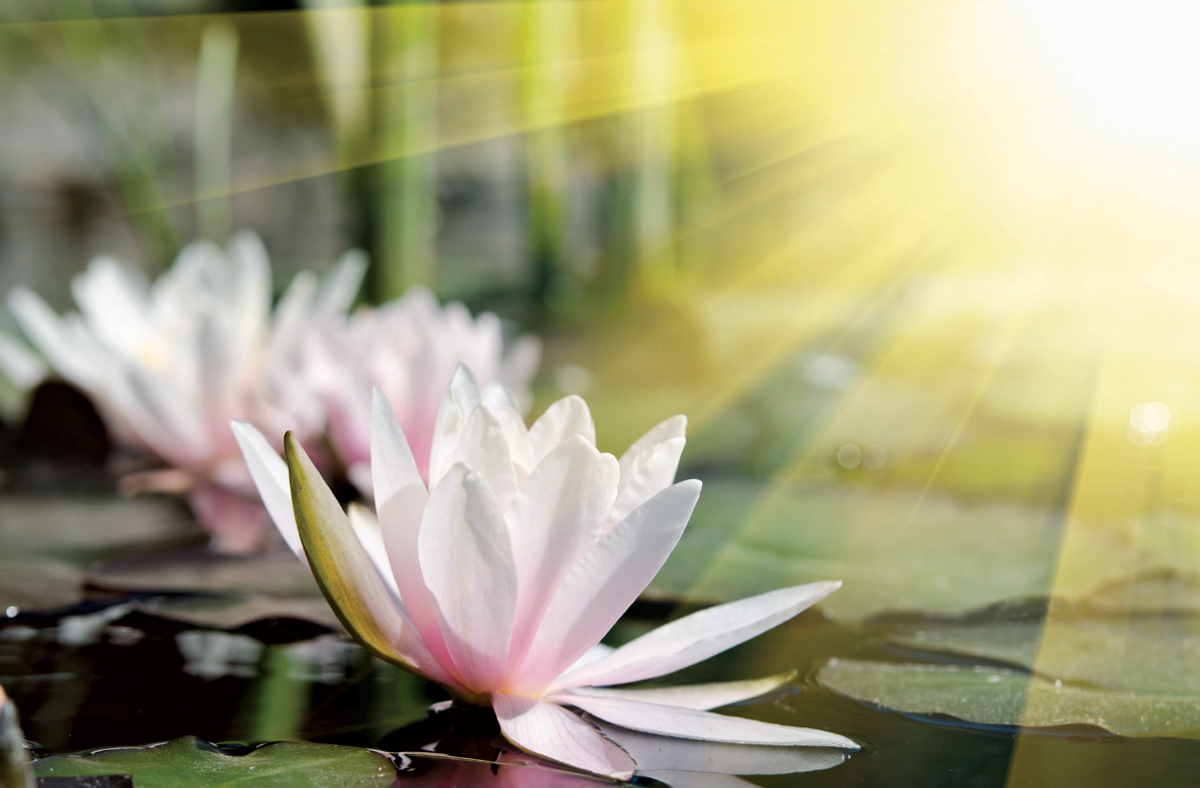Shanti and Shakti: peace and power
Shanti is a beautiful Sanskrit word for peace that unfolds the energy and harmony of the universal Shakti, the cosmic creative force. True Shakti, or power, must flow through Shanti, or peace, as the inner manifestation of the divine feminine grace. otherwise, it easily becomes aggression and only causes further division, turbulence and conflict.
The Sanskrit word Shanti encompasses calm, quiet, tranquility, peace, serenity, friendship, unity, concurrence, stillness and silence. Shanti ends many vedic peace chants, serving to carry the energy of peace in all of its aspects and manifestations. Shanti commonly occurs three times as Om Shanti Shanti Shanti, indicating peace for all the three worlds of earth, atmosphere and heaven.
The Sanskrit letter ‘sh’ has a soft sound, yielding deep healing vibrations. Even in the astrological mantra for Shanideva (Lord Saturn), we use mantra ‘sham’ as “Om Sham Shanaischaraya Namah” to soften the harsh energy of this strong planet. Sham, the seed sound of peace, holds the subtle power to appease, calm and slow down one’s actions, yet it carries the healing grace of Lord Shiva to allow us to move beyond our problems as well. The Devi form of Shambhavi holds the healing grace of Shiva, who is Sham-bhu or who emanates the power of Shanti.

Shanti is a beautiful Sanskrit word for peace that unfolds the energy and harmony of the universal Shakti, the cosmic creative force.
Shakti Sadhana cultivates a sankalpa or deep wish for eternal bliss or Ananda, but this is only possible through Shanti as deep peace and tranquility. We could say that Shakti Sadhana must also be Shanti Sadhana or it is not authentic. The true essence of Shakti dharma allows us to nurture the bhava of Shanti, or mode of peace, through all the main yogic paths of bhakti (devotion), jnana (knowledge), karma (action) and raja (willpower), bhakti yoga, or devotion, is the simplest of these ways of unfolding divinity in our lives, honoring the universal forces through mantras, rituals and selfless service, but true bhakti must start with inner peace. This means embracing the Divine as peace and calm, not with devotion as an emotional assertion or attachment expressed for the sake of others.

To balance and renew ourselves at a deep level, we must learn the yogic art of restorative healing by cultivating Shanti (inner peace). There are many tools to help us with the yogic practices of Pranayama, pujas, fire rituals, mantra, prayer, contemplation and meditation. We should cultivate the peace, or Shakti of Shanti, through the wisdom of ayurveda, Devi Tantra, vedanta, vedic astrology, and Yoga. Yet we must also approach these practices and studies with an inner peace and composure, not simply with an outer curiosity or ambition.

Jnana, or sacred knowledge, is most important for granting us the astuteness to maneuver with grace through our long karmic journey. Without the deeper wisdom, we can easily get waylaid by the temptations of maya, the allures of the outer world. maya holds the intrinsic play of worldly illusion and delusion, heightened in our commercial and media era of high-tech wonders, to keep our minds occupied externally and not to turn within. Yet without first creating a deep peace within ourselves, we will not have the vessel to hold this wisdom of meditation that alone can protect us from outer distractions.
Peace and the Guru
The role of the true guru is to manifest peace and to proclaim knowledge and power through peace alone (Shakti through Shanti). The true guru is the remover of all darkness and directs us to the higher light of reality. a guru must awaken us to the discriminating insight necessary to lead us from the shadowy play of maya to the Shakti of the supreme light. Yet a guru can only reveal this light to his disciples if he himself has held the knowledge through his own inner composure. It is not by the number of his followers or the size of his ashram, or the attractiveness of his picture, however interesting these may be.

The higher yogic teachings only unfold when we create a stillness born of peace in both our inner and outer existence. most of our energies are spent cultivating human drama, which is temporary and keeps us caught up in the number and name game, seeking to accumulate one thing or another. Recognition of our responsibility to promote peace, both for ourselves and others, is an important part of propelling us beyond the illusions of the world.
The great rishis, gurus and teachers of modern times such as bhagavan Ramana, Paramahansa Yogananda, vivekananda, anandamayi ma and Sri aurobindo had a dignified aura of divinity about them, a subtle play of Shakti born of knowledge, and a great power of peace. Their teachings brought a sense of responsibility into their disciples’ lives and a will to dedicate themselves to sadhana of self-realization, with steadiness and determination. Sri aurobindo, for example, taught that the first step and real foundation of sadhana was to bring a deep peace and stillness into the core of one’s being.
This knowledge given by the guru is the highest blessing of wisdom, which comprehends the play of Spanda Shakti, the trans-formative vibration of Shakti that creates the entire universe. The guru holds the responsibility to share this deeper wisdom to ignite the agni Shakti, or inner fire, the Kundalini which sets off the ripples or vibrations of self realization in the sadhak from within. but to do so, the teacher must first establish peace in the disciple, both at the core of the disciple’s being in the heart, and at the root foundation of his being, in the root chakra. Without being both centered and grounded in peace, our spiritual practices can lack stability. if teachers merely throw strong spiritual practices at those who have not first established a deep peace within themselves, the consequences are not always wholesome.
The path of self-realization is usually a solitary path, and is not found among congregations of hectic activity or stimulating entertainment. it is a path of deep introspection about the nature of awareness, not of mere moralistic platitudes or preaching about our outer appearances. We must take responsibility as mature human beings and not allow ourselves to be addressed as errant children, needing external correction or approval. The true guru cultivates a steadiness of peace in the disciple through clear instruction and guidance. This is a dialogue between the teacher and the soul of the student.
Self-realization is the fruit of wisdom combined with the discipline (tapasya) born of Shanti. only the knowledge that manifests as an enduring peaceful experience can relate to the highest form of moksha (liberation). Realizing the peaceful self and tapping its Shakti force requires a calming of the outer din and disturbance in our personal and social lives, including our emotional and psychological turbulence and imbalance. Only when we are able to comprehend the limitations of this worldly existence will we really begin making progress on the inner journey. Life can flow as grace, abundance and well being through a conscious astuteness born of one’s honest endeavors. We must take responsibility for our lifestyles and behavior and be bold in walking the path that we teach, not simply for the sake of others but for our own inner authenticity.

The light of peace
Shanti is light and we must exude the light which embraces all the forces of the universe in order to comprehend that peace. This light of peace must be expansive through its pure rays that impartially illumine everything. The light we normally share with the world is a mere torchlight that highlights our outer personalities and mundane achievements, where followers are blinded by a neon display of showmanship in those they seek to guide them. This outer show can remove us from our inner peace and become only another form of stimulation and addiction.
When we refer to the “light of knowledge,” we mean the cosmic light of the universe that carries the innate vibrations of Shanti and quietude. We do not mean any mere human cunning or skill of expression. how can we relate to this light unless we first come to understand its profound secrets?
The spiritual heart is said to be like a hidden cave, a small space that contains a secret vastness deep inside that can comprehend all of time and space. it is not of easy access to anyone and no one can take this inner journey for you. it requires a profound search and a dedicated introspection even to begin the approach.
In all dharmic traditions, the ritual of lighting the lamp is sacrosanct. The ghee lamp is an offering representing the elements or cosmic principles, where the earthen diya lamp is a manifestation of mother Earth. The ghee represents fire, the smoke represents air, the sweet essence of the burning ghee manifests as ether, and the colors of the flame represent our maya. Yet the wick manifests as jnana or wisdom in its ability to illumine.
This wick in the diya is most important in understanding the Shakti of light. The wick needs to be nurtured or else the light extinguishes. one has to nurture, comprehend, experience and realize this knowledge, which means that we cannot light the lamp in the heart without great care, respect, consideration and deep peace. This inner light only burns in stillness and peace. if the winds of our outer mind, senses and emotions are blowing strong, that light will quickly go out if we can light it at all.
Peace and nature
The quality of Shanti must unfold as harmony with mother nature. Today’s satsangs are often more about blaring loud speakers and larger-than-life stages. Where is the place for silent strains of divinity amidst this circus of maya? In the older yogic traditions, teachings were given in nature, in the forests and by the rivers, where nature created the stage and formed the background. This brought a natural peace and vastness into every discourse and every meditation.
Working with Shakti requires a sadhana through which we consecrate the Divine within ourselves as a celebration of the mother goddess. Surrounding ourselves in nature, using flowers, incense, rituals and silent prayer can awaken the aspiration of the heart. it is important to be aware of the natural symbolism which carries this Shakti force. All life is a movement of Shakti and its purpose is to draw us into a deeper peace. There is no other way either to deal with the turbulence of the human world or to connect with the greater forces of the universe than to honor that Shakti both in and around us.

In our homes, workplaces, and in the outer world we must consecrate the sacred through creating an intimate space where we honor the divine powers of life. The energies of our sacred space allow us to create a sense of sthira (resoluteness), dependability, steadfastness and devotion. We need to revere and empower our sacred space with our prayers, simple rituals, mantras, lighting incense and the diya or oil lamp, and all such related practices. it is the simplicity and conviction of our deep felt divinity that awakens this supreme force of the divine feminine energy, the Shakti power, if we sincerely and consistently open our lives to it.
The entire universe is a manifestation of the complimentary principles of Soma and Agni, as the primal powers of bliss and light. Agni, or fire, has the power to nurture, cultivate, purify, or even destroy. Soma, or the divine nectar, grants us the blessings of love, water and rain, the auspiciousness of Shakti. may our prayers invoke this auspiciousness of creativity and abundance, the vivid symbols of life-giving sustenance, the energies of both material and spiritual well-being.
To find our bliss, we must first create a peace within ourselves that is linked to the universal peace, such as we find expressed in the vedas. This is not a man-made peace, which is often little more than a truce between wars, but the peace of the mountains, rivers, forests, sky, atmosphere and earth. There the universal Shakti resides with an unlimited and inexhaustible power, but that power is contained in peace and only manifests as needed, whether for creation, preservation, or dissolution. This inner peace is beyond all propaganda and not meant for any outer show or reward. it surrounds us on every side – if we would but shift our vision to the divine presence that is the ocean in which we live.
Surrounding ourselves in Nature, using flowers, incense, rituals and silent prayer can awaken the aspiration of the heart. It is important to be aware of the natural symbolism which carries this Shakti force.

May that universal peace, or Vishva Shanti, enter into all that you do, feel or think, as a blessing for your inner being and for the benefit of all. but you must first become a vessel for it, which means to purify yourself of all that is not peaceful within the mind and heart, including all gossip, comparison and aggression. This is a great challenge in our human world born of conflict and duality, where competition is encouraged nearly everywhere. but this inner purification can be achieved by grace and determination born of an enduring peace. There is no other way to move beyond sorrow, which is what we are all seeking in the end.
May we know the peace of peace, the Shanti of Shanti, which carries the highest Shakti of healing and grace!
 Shambhavi Chopra is a mystic, yogini and spiritual guide. She is a dynamic teacher of Shakta or Goddess traditions of India. She draws the seeker through Shakti Sadhana and Tantra, emphasizing the role of the “Divine Feminine Power,” creating an inner and outer transformation through meditation, sacred rituals, mantra japa, healing and Pratyahara. Shambhavi has written bestselling books. vedanet.com
Shambhavi Chopra is a mystic, yogini and spiritual guide. She is a dynamic teacher of Shakta or Goddess traditions of India. She draws the seeker through Shakti Sadhana and Tantra, emphasizing the role of the “Divine Feminine Power,” creating an inner and outer transformation through meditation, sacred rituals, mantra japa, healing and Pratyahara. Shambhavi has written bestselling books. vedanet.com





















